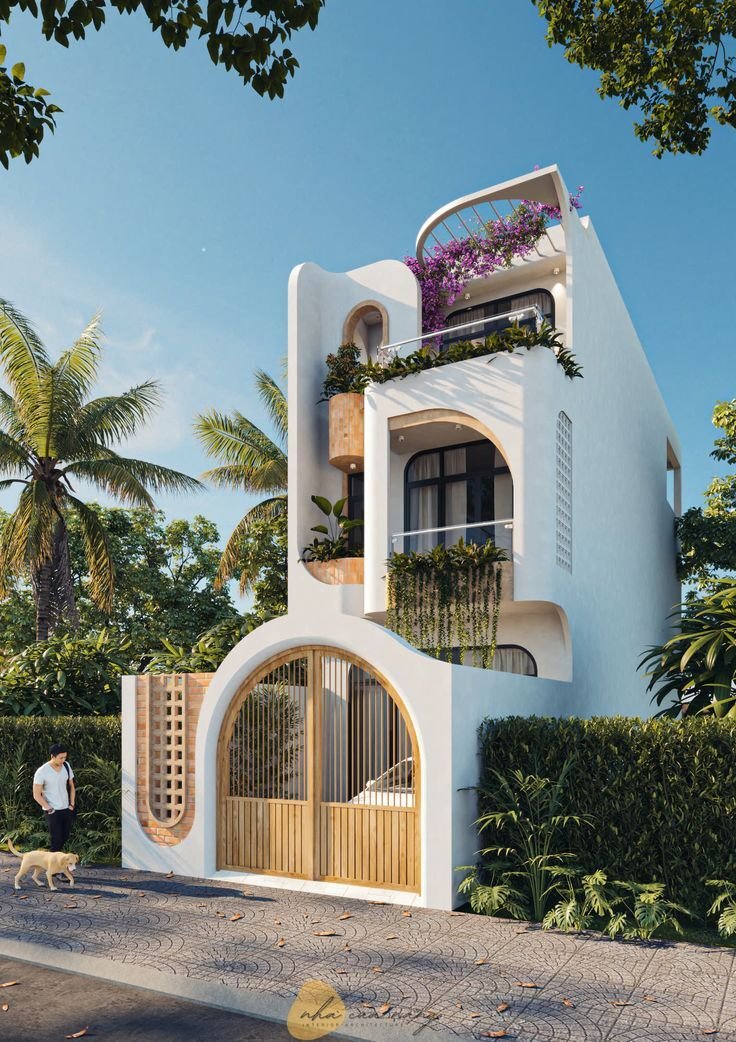The relationship between architecture and human well-being has gained increasing attention in recent years, as architects, urban planners, and designers recognize the profound impact that the built environment can have on physical, mental, and emotional health. Thoughtful architectural design goes beyond aesthetics, shaping spaces that promote comfort, reduce stress, and foster a sense of connection with nature and community. As our understanding of well-being evolves, so too does the approach to creating healthier living and working environments. This article explores how architecture intersects with well-being and the trends that are enhancing human health through design.
1. Biophilic Design: Reconnecting with Nature
One of the key principles connecting architecture and well-being is biophilic design, which focuses on integrating natural elements into the built environment. Studies have shown that exposure to nature has numerous psychological and physiological benefits, including reduced stress levels, enhanced mood, and improved cognitive function. Biophilic architecture aims to bring these benefits into daily life by incorporating features such as:
- Natural light and ventilation: Large windows and skylights that maximize natural light exposure and encourage air circulation.
- Green spaces: Indoor plants, vertical gardens, and green roofs that introduce nature into urban settings.
- Water features: Fountains and reflecting pools that create a calming atmosphere.
- Natural materials: Wood, stone, and other organic materials that evoke a connection to the natural world.
Biophilic design is increasingly being incorporated into workplaces, hospitals, and residential spaces, creating environments that nurture well-being by fostering a deeper connection to nature.
2. Light and Its Role in Health
Lighting, both natural and artificial, plays a critical role in influencing well-being. Circadian lighting—lighting that mimics the natural progression of daylight—is being used in architectural design to regulate people’s internal clocks, which is crucial for maintaining sleep patterns, mental clarity, and overall health.
Incorporating abundant natural light into spaces not only improves mood but also boosts productivity and helps regulate sleep-wake cycles. In environments like schools, hospitals, and offices, where people spend long periods indoors, natural light is essential for maintaining well-being. Architects are increasingly designing buildings with expansive windows, open floor plans, and strategic skylights to ensure that natural light reaches every corner of the space.
Artificial lighting is also evolving, with smart lighting systems that adjust color and intensity throughout the day, supporting the body’s natural rhythms. These innovations in lighting design are transforming how we interact with spaces and how those spaces support our health.
3. The Psychology of Space: Promoting Comfort and Calm
The psychological effects of spatial design are undeniable, and architects are paying more attention to how the layout and form of spaces influence emotions. Open and flexible spaces can reduce feelings of confinement and promote creativity, while spaces that offer a sense of privacy and control help reduce anxiety and stress.
- Spatial flow and organization: Well-organized layouts that minimize clutter and confusion can create a sense of calm and order, helping individuals feel more comfortable in their environments.
- Soothing colors and textures: Soft, muted colors, combined with tactile materials like wood or fabric, can contribute to a calming atmosphere.
- Acoustic comfort: The design of spaces to minimize noise and improve acoustic quality is crucial for maintaining mental well-being, particularly in environments like offices or healthcare settings where concentration and relaxation are essential.
Architects are using these principles to create wellness-focused spaces in homes, schools, offices, and public buildings that support both mental and physical health.
4. Designing for Social Connectivity and Community
Human beings are inherently social, and architecture plays a critical role in facilitating community and interpersonal connection. Spaces that encourage social interaction—whether through open communal areas, shared gardens, or public spaces—can foster a sense of belonging and improve mental well-being.
Urban planners are designing mixed-use developments that blend residential, commercial, and recreational spaces to create vibrant, walkable neighborhoods that promote social interaction. This type of design reduces isolation by making it easier for people to connect with their neighbors and engage in community activities.
In workplaces, collaborative spaces are replacing traditional cubicles and private offices, encouraging communication, teamwork, and innovation. In residential developments, communal spaces like shared courtyards, parks, and rooftop gardens are being used to bring people together, fostering a sense of community and improving well-being.
5. The Role of Architecture in Physical Health
Beyond mental and emotional well-being, architecture also plays a vital role in promoting physical health. The design of buildings and cities can encourage active lifestyles, reduce exposure to harmful environmental factors, and improve overall quality of life.
- Active design principles: Features like staircases that are prominently placed and aesthetically pleasing encourage people to choose them over elevators, promoting physical activity. Walkable urban environments, bike lanes, and access to parks are also being incorporated to support an active lifestyle.
- Air quality and ventilation: Proper ventilation systems and air filtration are essential in reducing indoor pollutants, improving respiratory health, and preventing the spread of airborne illnesses. Healthy air is a priority in the design of hospitals, schools, and homes.
- Access to healthy food: Architectural design can also play a role in food access. Urban farms, rooftop gardens, and nearby markets can ensure that residents have easy access to fresh, nutritious food, improving dietary health.
By prioritizing the integration of active design, clean air, and accessible food sources, architects are shaping spaces that not only look good but actively contribute to healthier living.

6. Healing Environments in Healthcare Architecture
Healthcare architecture is a prime example of how design can directly impact well-being. Healing environments are designed to reduce patient stress, speed up recovery, and enhance the overall experience of both patients and healthcare professionals.
- Natural light and views of nature: Research has shown that patients with access to natural light and views of nature recover faster and experience less pain and anxiety. Healthcare facilities are now incorporating large windows, gardens, and calming natural elements into their designs.
- Noise reduction: Noise is a significant source of stress in hospitals. Modern healthcare architecture focuses on minimizing noise pollution through better soundproofing, quieter equipment, and thoughtful space planning.
- Soothing interiors: Soft colors, comfortable furniture, and thoughtful lighting are used to create a welcoming and calming atmosphere that supports healing.
These patient-centric design principles not only improve patient outcomes but also reduce stress for healthcare providers, creating an environment where everyone can thrive.
7. Architecture and Mental Health
With the growing awareness of mental health issues, architects are taking steps to design spaces that promote mental well-being. Schools, offices, hospitals, and even homes are now being designed with a focus on reducing stress, anxiety, and depression.
- Access to nature: Incorporating natural elements like greenery, water, and sunlight can have a positive impact on mental health, providing relief from stress and enhancing mood.
- Quiet, private spaces: In environments like schools or workplaces, offering quiet areas for reflection or decompression can help individuals manage stress and maintain focus.
- Inclusive design: Spaces designed for inclusivity—ensuring accessibility for people with disabilities or neurodiverse individuals—create environments where everyone can feel safe, valued, and supported.
Conclusion
Architecture has the power to shape not just the physical spaces we inhabit, but also our health, well-being, and quality of life. By embracing principles of sustainability, biophilic design, and social connectivity, architects are creating spaces that promote physical, mental, and emotional well-being. As the understanding of well-being continues to evolve, the role of architecture in supporting human health will only become more integral, shaping the way we live, work, and interact with the world around us.



